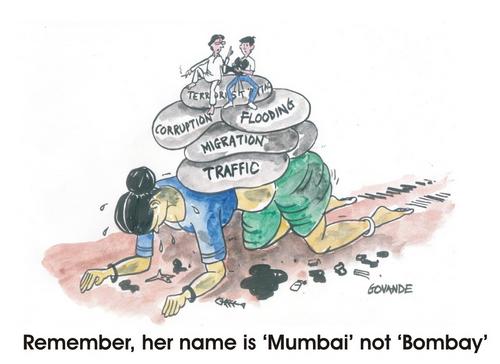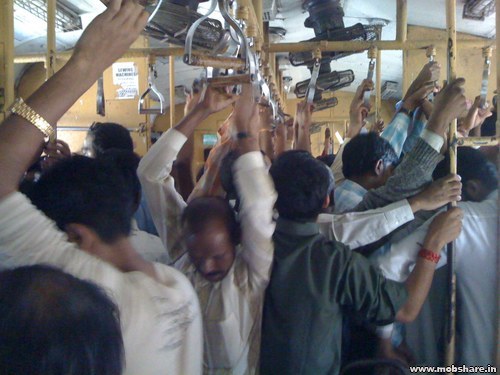Mumbai vs Bombay
 Is it a crime to refer to one of India’s finest cities as Bombay instead of Mumbai? Certainly not. But it is certainly a crime to threaten people with violence if they refer to the city as Bombay. I was born, brought up and educated in Bombay and apart from English the other national language, which I speak is Marathi. I have a hill station home in Mahabaleshwar, have visited Pratapgarh more than once because Shivaji is my hero. If one calls the city Bombay, my pride as a Maharashtrian is not hurt because my pride in the city stems from its preeminence and cosmopolitan character and not from use of the name, Bombay or Mumbai. Significantly there has been no threat of violence against persons who continue to mention Bangalore or Calcutta. Karan Johar’s yielding to Raj Thackeray’s threats has disturbing implications. It gives undeserved recognition and prominence to an extra-constitutional authority. It is an abject surrender to bigotry and blackmail, and is a lamentable instance of commercial expediency. A film producer is most interested in the success of his movie rather than upholding freedom of expression and the rule of law. To be fair to Johar, one compelling reason for his behaviour could be lack of confidence in law enforcement authorities to give him necessary protection against violence by goondas masquerading as Maharashtrian patriotic. That is the real tragedy. It is also a sorry reflection on the rule of law in some parts of our country. The Chief Minister of Maharashtra’s grievance that Johar should have approached him is specious. It is extremely unlikely that in view of the oncoming elections, the Chief Minister would have posted adequate police force at the theatre and given him effective security.
Is it a crime to refer to one of India’s finest cities as Bombay instead of Mumbai? Certainly not. But it is certainly a crime to threaten people with violence if they refer to the city as Bombay. I was born, brought up and educated in Bombay and apart from English the other national language, which I speak is Marathi. I have a hill station home in Mahabaleshwar, have visited Pratapgarh more than once because Shivaji is my hero. If one calls the city Bombay, my pride as a Maharashtrian is not hurt because my pride in the city stems from its preeminence and cosmopolitan character and not from use of the name, Bombay or Mumbai. Significantly there has been no threat of violence against persons who continue to mention Bangalore or Calcutta. Karan Johar’s yielding to Raj Thackeray’s threats has disturbing implications. It gives undeserved recognition and prominence to an extra-constitutional authority. It is an abject surrender to bigotry and blackmail, and is a lamentable instance of commercial expediency. A film producer is most interested in the success of his movie rather than upholding freedom of expression and the rule of law. To be fair to Johar, one compelling reason for his behaviour could be lack of confidence in law enforcement authorities to give him necessary protection against violence by goondas masquerading as Maharashtrian patriotic. That is the real tragedy. It is also a sorry reflection on the rule of law in some parts of our country. The Chief Minister of Maharashtra’s grievance that Johar should have approached him is specious. It is extremely unlikely that in view of the oncoming elections, the Chief Minister would have posted adequate police force at the theatre and given him effective security.
To many like myself, Mumbai aamchi is more appealing than Bombay aamchi. For a Sunday breakfast to some, Bombay duck sounds better than Mumbai duck. It is ultimately a matter of choice and not of compulsion. Let us concentrate on making our beloved city greater rather than squabbling over names and issuing threats smacking of fascism.
Local-Where Mumbaikars meet

"gardi melichi"
Local Trains are the major means of transport in Mumbai. Most of the city-dwellers rely on Mumbai Suburban Railway to travel within the metropolis. The extensive network of Railways has three lines, namely the Western Line, the Central Main Line and the Harbour Line. Being a linear city, Mumbai is totally covered by local train network. The area from Churchgate to Virar is covered under the Western line via Western Suburbs, while the Central Main Line starts from Chhatrapati Shivaji Terminus (CST) and travels to Kalyan through the Central Suburbs and Thane.
Kurla is the interchange point with the Central Main Line. Between Mumbai CST and Vadala, there is a common stretch of the Harbour Line. However, this line divides into two spurs, the major one heads for the Eastern Suburbs, Navi Mumbai and eventually Panvel, while the other one goes till Mahim on the Western Line and runs parallel upto Andheri. Its interchange stations are sited at Bandra and Andheri.
All the local trains start operations usually after 04:00 hours in the morning and close maximum by 01:00 hours. Traveling in second class is definitely very cheap, but it is exceptionally crowded. For tourists, it is better to travel in the expensive first class, rather than experience any trouble in the economy class. During rush, office or peak hours, one should avoid traveling in local trains because they are jam-packed.
The peak hours extend from 08:30 till 10:30 towards CST and Churchgate and from 17:30 to 20:30 pm in the opposite direction. For women, there are special coaches on both classes in all the trains. They are quite better and safer than the common ones. Local trains are the most common and easy means to travel in the city. In case, there is a group of people, then prefer taxis and auto-rickshaws over local trains in Mumbai.
MUMBAI- the pride of nation
Mumbai (Marathi: मुंबई, Mumbaī, IPA:![]() [ˈmʊm.bəi] (help·info)), formerly Bombay, is the capital of the Indian state of Maharashtra. The city proper is the most-populous in the world, with approximately 14 million inhabitants.[1] Along with the neighbouring suburbs of Navi Mumbai and Thane, it forms the world’s 4th largest urban agglomeration, with around 19 million people.[3] Mumbai lies on the west coast of India and has a deep natural harbour. As of 2009, Mumbai was named an Alpha world city.[4]
[ˈmʊm.bəi] (help·info)), formerly Bombay, is the capital of the Indian state of Maharashtra. The city proper is the most-populous in the world, with approximately 14 million inhabitants.[1] Along with the neighbouring suburbs of Navi Mumbai and Thane, it forms the world’s 4th largest urban agglomeration, with around 19 million people.[3] Mumbai lies on the west coast of India and has a deep natural harbour. As of 2009, Mumbai was named an Alpha world city.[4]
The seven islands that came to constitute Bombay were home to communities of fishing colonies. For centuries, the islands came under the control of successive kingdoms and indigenous empires before being ceded to Portuguese settlers and subsequently to the British East India Company. During the mid-18th century, Bombay emerged as a significant trading town. Economic and educational development characterised the city during the 19th century. It became a strong base for the Indian independence movement during the early 20th century. When India became independent in 1947, the city was incorporated into Bombay State. In 1960, following the Samyukta Maharashtra movement, a new state of Maharashtra was created with Bombay as the capital. It was renamed Mumbai in 1996.[5]
Mumbai is the commercial and entertainment centre of India, generating 5% of India’s GDP,[6] and accounting for 25% of industrial output, 40% of maritime trade, and 70% of capital transactions to India’s economy.[7] Mumbai is home to important financial institutions such as the Reserve Bank of India, the Bombay Stock Exchange, the National Stock Exchange of India and the corporate headquarters of numerous Indian companies and multinational corporations. The city also houses India’s Hindi film and television industry, known as Bollywood. Mumbai’s business opportunities, as well as its potential to offer a higher standard of living, attract migrants from all over India and, in turn, make the city a potpourri of many communities and cultures.